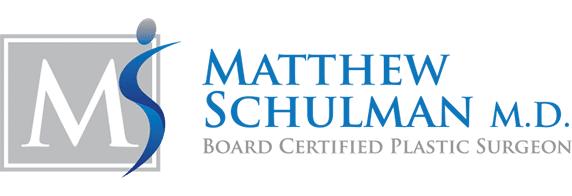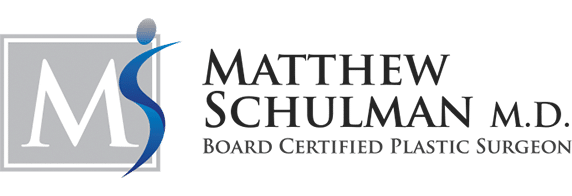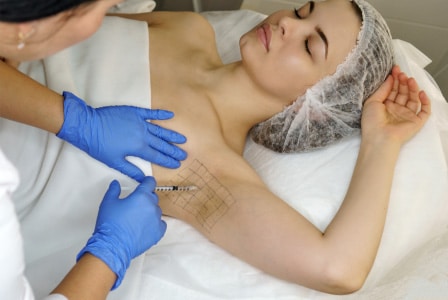Breast augmentation is the most popular plastic surgery procedure in the United States, accounting for over 300,000 procedures annually, most of which are performed in fairly standard way. A plastic surgeon places an implant, made either from saline or silicone, behind either the breast tissue or the chest wall, often tightening and lifting the skin and muscles in the area in the process.
But what if there was a better way to perform breast augmentations?
Dr. Matthew Schulman has pioneered a new approach to breast augmentation that uses Botox to speed breast augmentation recovery. Though not yet practiced widely, Dr. Schulman’s approach can also make post-surgery recovery less painful and can help patients realize their new appearance sooner.
Botox-Assisted Breast Augmentation: How It Works
To understand why Botox-assisted breast augmentation is so beneficial, it’s important to look more closely at how the procedure works. Though largely similar to conventional breast augmentation with breast implants, Dr. Schulman begins this version of the procedure by injecting Botox into the chest wall to weaken the muscles, applying the chemical properties of botulinum toxin – commonly used to reduce wrinkles – in a new context.
Post-surgery, the temporarily weakened muscles are less likely to spasm, reducing post-surgical pain and allowing patients to get back to their typical activities more quickly.
Though Dr. Schulman is one of just a few board certified plastic surgeons using Botox in the breast augmentation surgery process, he has seen great success because he uses it in a highly targeted way. The procedure uses no more Botox than would be appropriate for facial wrinkles, well within the known safe range. The dose of Botox wears off within three months, the ideal time frame for patients healing from breast implants, well after concerns about post-operative spasms have faded.
Who Makes A Good Candidate?
Botox-assisted breast augmentation doesn’t necessarily change surgical outcomes, but given how long surgery can leave women out of commission, many women consider Dr. Schulman’s approach worth pursuing. A certain subset of patients, however, may particularly benefit from this approach, including those who want to avoid the need for opioid pain relievers and who work physical jobs and need to shorten recovery time.
In an era marked by the opioid epidemic and concern over prescribing such medications, more doctors should aim to reduce their use. Botox can also reduce the uncomfortable feeling of tightness that many patients experience after breast augmentation surgery.
Another group that can benefit from Botox-assisted breast augmentation are patients who want to achieve final results on a short timeline – for an upcoming wedding or vacation, for example. That’s because in a typical breast augmentation surgery, the implant isn’t placed in its final position, but rather into a pocket in the chest, from which it will eventually drop into its final, natural placement. In Botox-assisted breast augmentation, however, the weakened muscles allow the implants to drop into their final position within three to four weeks.
This can allow women to see the final results of the procedure within three to four weeks, rather than the three to six months it would typically take. It can be hard to wait to see the end result of such procedures, and Botox helps patients get there faster, without substantially changing the procedure.
While using Botox can speed the aesthetic aspects of recovery, it can also be a powerful tool for patients who work physical jobs or have a limited amount of time off. Though these patients still need to be very careful about being too active after surgery, by reducing pain and helping the implants settle, patients can safely get back to their normal routines more quickly. Many athletes who want to get back to training sooner also prefer this type of breast augmentation.
Are There Concerns About Off-Label Use?
Botox isn’t approved for use in breast augmentation, meaning that Dr. Schulman’s approach is considered to be “off-label” use – but patients shouldn’t be put off by that fact. Many medications are used off-label with great success, and Botox is actually used off-label to treat hyperhidrosis and jaw issues leading to teeth grinding, among other applications. Once a medication has been approved, doctors have significant freedom to use it as they see fit.
Many people worry that injecting Botox into the chest wall might interfere with the patient’s ability to breathe, but the injection does not impact the diaphragm, nor does it fully paralyze the muscles. Rather, when used in breast augmentation surgery, Botox simply weakens structural muscles in the area of the rib cage, a harmless application.
Regarding the use of Botox for breast augmentation, then, as long as a doctor approaches the procedure with care and monitors their patients throughout, there are no major concerns – and Dr. Schulman is the leading practitioner of Botox-assisted breast augmentation. He has found Botox-assisted augmentations to be no riskier than standard breast augmentations, while actually being easier on the body during the recovery process. There is no greater risk involved in adding Botox to the main procedure than in using Botox for any other purpose.
 Preparing For Botox-Assisted Breast Augmentation
Preparing For Botox-Assisted Breast Augmentation
Overall, preparing for Botox-assisted breast augmentation is not unlike preparing for the more conventional version of the procedure. Patients will need proper support at home during the first few days of recovery, including arranging for childcare and pet care, and should plan a modified fitness routine, as exercise can facilitate the healing process. Individuals who have previously had this procedure also recommend arranging for help with housekeeping and other chores.
In addition to arranging for help during the first week or two after surgery, patients will also need someone to pick them up after surgery, which is generally performed as an outpatient procedure, not requiring a hospital stay. Botox-assisted breast augmentation will get patients back on their feet faster, but it’s still important to be gentle with your body during the recovery process.
Questions and Answers
Can Botox be used for fat transfer breast augmentation?
Botox-assisted breast augmentation, while innovative, remains off-label as it lacks FDA approval. Like traditional procedures, it carries similar risks.
Can Botox help saggy breasts?
Moreover, Botox fails to address skin stretch and breast tissue sagging, which drive women to seek surgical correction with a breast lift. Nipple and areola repositioning is also not within its scope.
Get The Best Results With Dr. Schulman
If you’re considering undergoing breast augmentation, you need an expert on your side, and in the case of Botox-assisted breast augmentation, there’s no one as experienced as Dr. Matthew Schulman.
To learn more about his technique, Botox-Assisted Breast Augmentation scars and whether it may be right for you, contact our offices today to set up a consultation. We look forward to helping you find the best procedure for your needs.
References
https://www.allure.com/story/off-label-uses-for-botox-injections



 Preparing For Botox-Assisted Breast Augmentation
Preparing For Botox-Assisted Breast Augmentation
